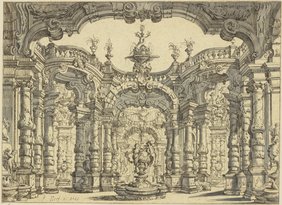In the well known compendium of the "Great Schouburgh of the Dutch painters" (Amsterdam 1718-19) there is also a short entry by Arnold Houbraken (1660-1719) about the Antwerp painter Pieter Neefs the Elder (ca. 1578-1656/1661). The artist had painted perspectives of princely palaces and galleries, but especially interior views of churches with their furnishings. Houbraken, himself a well-known artist, concluded his short entry with the remark: "Een arbeidsame verkiezing, die ik liever wil zien dan zelf maken." (A laborious task that I would rather see than do myself).
With his meticulous depiction of mostly Gothic church interiors, Pieter Neefs, a member of Antwerp's St Luke's Guild, had opened up a market niche for himself in Dutch architectural painting, which his son of the same name continued to serve. Today, their paintings are represented in many renowned painting collections worldwide, but there is hardly any evidence of original drawings by their hand. All the more remarkable, therefore, is the drawing from Haupts collection, which provides an insight into Neef's alternative work.
Drawn in a light hand, the space of a fountain courtyard designed in central perspective opens up to the viewer, its complex architecture formed by arcade bays swinging in and out. In the visual axes of the arches, this architecture continues into the seemingly infinite. Rustica and bud elements on the columns, entablature and arches, as well as the figural decoration with tritons and fish, are reminiscent of the grotto architecture of the late Italian Renaissance and indicate the print as a mannered design for a fantasy scene - possibly a setting for an ancient mythological scene of a stage work.
Haupt acquired the sheet at an auction in Leipzig in 1898 from the former collection of Karl Eduard von Liphart. In its rather cautiously formulated artistic assessment as a "diligent pen and ink drawing" in the auction catalogue, one is reminded of Houbraken's remark. At the time, Joseph Eduard Wessely (1826-1895) had a somewhat more refined opinion of Neef's artistic ability: "In the conception and execution of such pictures, he demonstrated the most complete knowledge of (...) perspective. In the distribution of light and shadow he was unsurpassable, and even in the deepest shadows he was still transparent."(ADB 1886) One can still agree with Wessely's judgement without reservation when looking at the drawing today.
sp

